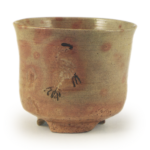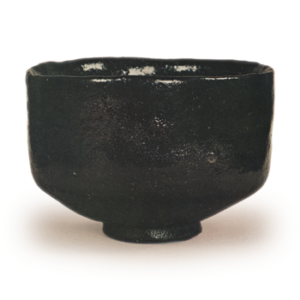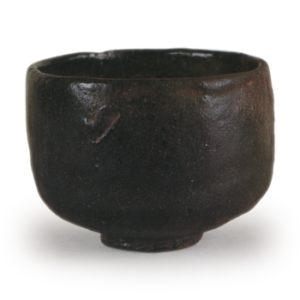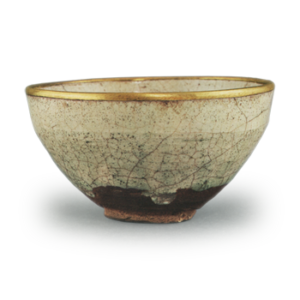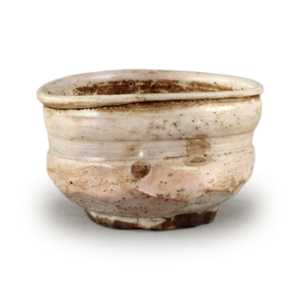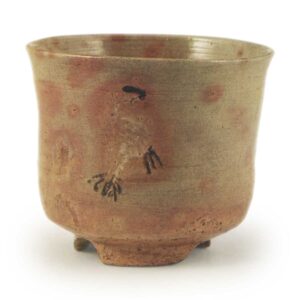
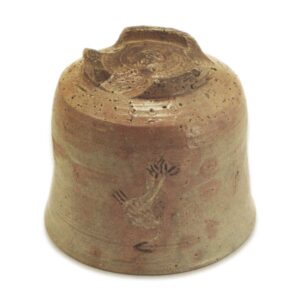
Height: 9.8-9.9cm
Diameter: 11.2-11.5cm
Outer diameter of foot ring: 6.4cm
Height of foot ring: 1.0cm
The Tachikaku tea bowl is the most famous of the Busan Kiln’s Gohon tea bowls, and the name Gohon is now almost synonymous with the Tachikaku. The Tachikuru was extremely popular with tea ceremony practitioners, so it was often ordered and fired at the Busan Kiln, but the first piece is particularly distinguished as the “Honte” (original) Tachikuru. The legend that the Honte Tachikuru was based on a picture of a crane drawn by Hosokawa Sansai to celebrate the birthday of the Shogun Iemitsu is also said to have contributed to the fame of the Tachikuru tea bowl. It is said that the Mamekouwa-yakata pottery was opened in 1639, and this is probably one of the first pieces made there.
The main body of this piece is thin and cylindrical, with a slightly constricted body and a slightly upturned rim. There are two standing cranes stamped on the front and back of the body, and the inlay is black and white. The foot is three-sectioned, and the sides are cut around. The body is made of fine red clay, covered with a translucent water glaze, and has a clay foot ring. The overall color is a light persimmon, and the characteristic red speckles and fire-changing of the gosho form a beautiful scene, and the finger marks and missing glaze also add to the charm. Compared to later Rikyū ware, the workmanship and glaze application are all far superior, but for example, the way the foot ring is cut into three parts is very casual and fresh, and there is a world of difference from the formalized style of later works. In addition, the overall elegance associated with the old style is overflowing.
There are only a few Hon-teduru cranes, including the Ueno, but this bowl in particular is said to be the best of the Hon-teduru group, and it is said to have been passed down through the Juichiya family in Nagoya. The rim is elegantly curved, and the curvature of the body is slightly tightened, creating a change in the overall appearance. The light persimmon-colored base is slightly bluish, and the deer spots and fire marks are beautifully reflected on the surface. There are finger marks and loose joints from the body to the hem. The fine lines of the pull-out are sharp and clear both inside and out, and the inside of the body is covered in a pattern of small spots, with a fire pattern visible. The cut-out around the base is gentle, and the whole surface is beautifully reddish with the presence of the an-ana. The helmet-shaped hood inside the stand is sharply upright, and the three-piece division that was cut in one go is vivid.
Although the work is full of the original intention of the cut shape, the skill of the local potters is not lost in the details, and the work that makes full use of the taste of the original Korean pottery techniques and is overflowing with elegance must be praised. Accessories:
Inner box: paulownia wood
Outer box: Shunkei lacquer
It was originally owned by the famous Nagoya family of Jūichiya (Ko-Okeya), and later became the property of Mogi Sobei of Yokohama, but in 1921 it was sold at auction to the family of Hara Sankei for the high price of 48,000 yen. At that time, the story of Masuda Don’o and Morikawa Yoshiharu sending a telegram to Sankei advising him to buy the property regardless of the price is well known, and the telegram is included as a reference. In recent years, it has come to be owned by the current owner.

